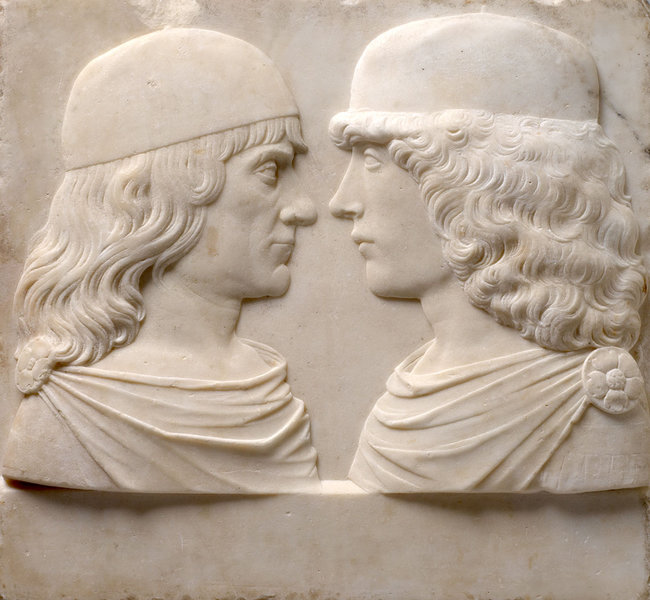Discover entertaining essays on a wide variety of artworks from our extensive collections in the section Art Stories.

It was Andreas Brunner, a historian and the head of the Archiv QWIEN (Centre for Queer History), who first drew my attention to this work. It is one in a long line of historical objects whose queer dimensions research and historiography have long ignored or swept under the carpet. At the same time, it is artworks like this one that bear witness to the fact that different forms of desire and relationships outside traditional hetero-normative culture have always been – and very much still are - part of society.
Probably produced around 1495/1500 in the workshop of Pietro Lombardo in Venice, this marble relief depicts two men in profile, each soulfully gazing at his companion facing him. The two men - one older, the other younger - wear clothes reminiscent of classical antiquity but sport Venetian hairdos and head coverings. Although only a bas-relief, textures, wrinkles, hair and clothes are fastidiously recorded and rendered in such detail that the two heads appear three-dimensional and highly naturalistic. The templates for such depictions popular in Venetian sculpture at the turn of the sixteenth century were presumably ancient gems, cameos and coins which often depict two heads in profile facing each other.
We cannot be sure about the identity of the men gazing so intently at each other. The work was long identified as either a double portrait of the painter Gentile Bellini and his brother Giovanni, or as exemplary idealized figures representing the contrast between youth and old age. Today, art historians believe that the relief most probably depicts the painter Giovanni Bellini and his younger lover. A number of contemporary poets celebrated the young man’s exceptional beauty, among them Girolamo Priuli and Bartolomeo Fuscus. Extant drawings of Bellini and a young man can also be associated with the profiles of the sitters in this marble relief.
The relief also contains a number of clues about society and sexuality in Renaissance Italy. Gazing into the eyes of someone may be read as a sign of reciprocated love according to theologians and philosophers like Marsilio Ficino who believed in the infectious power of exchanging glances through which one can catch the sickness of love. At the same time, the two sitters’ shared fixed look constructs a closed entity that does not make contact with the viewer but excludes them. The importance of a gaze for love is also discussed in Phaedrus, a fictional dialogue by the Greek philosopher Plato that was hugely popular during the Renaissance and impacted philosophy, art and literature.
Is Lombardo’s relief and its history perhaps an exception in sixteenth-century society? Numerous sources, court files, poems, letters and artworks document the opposite. Even if terminology differed in the fifteenth and sixteenth century and a person’s sexual orientation was, unlike today, not regarded as part of their identity, this does not mean that there did not exist numerous forms of sexuality and love. One important source, for example, are the files of the ufficiali di note, the vice squad of Florence, which show that same-sex sexuality was not the exception in the fifteenth century - on the contrary, it was omnipresent. However, only men discovered engaging in same-sex erotic activities were prosecuted. Women’s lives were mainly restricted to the privacy of their home which means the body of extant source material is much smaller.
We should also not underestimate the influence of classical antiquity, which functioned as an exemplary model for Renaissance art and culture. Classical texts like Plato’s Phaedrus were widely read, commented and discussed. They show that homoerotic love between men was regarded as the ideal and was widely practiced. A normal constellation was a relationship between an older, experienced man and a younger one, who regarded his elder lover as a teacher or mentor. In the fifteenth and sixteenth century, we find numerous examples of such relationships among members of the humanist-educated elite, suggesting that the sitters in Lombardo’s relief with its clear references to classical fashion and aesthetics should be seen in this context.
For me, this relief and its history are a plea to open one’s eyes to the diversity of human sexuality, to desire and love that have always been part of society, and to preserve and cherish the history/ies of queer people.
Larissa Kopp is an artist and works as a docent at the Kunsthistorisches Museum Vienna. In her work she focuses on questioning norms and traditional perception mechanisms, collaborative processes, and developing new approaches and forms of education/communication for a diverse audience.